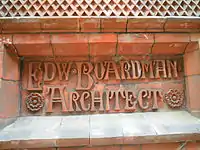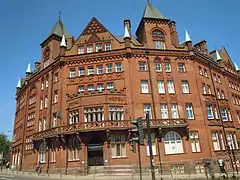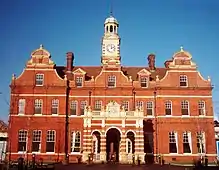Edward Boardman
Edward Boardman (1833–1910) was a Norwich born architect. He succeeded John Brown as the most successful Norwich architect in the second half of the 19th century.[1] His work included both civic and ecclesiastical buildings, in addition to private commissions.[2] Together, with his rival, George Skipper, he produced many notable buildings with several standing to this day (2013).
Edward Boardman | |
|---|---|
 Sign outside the former office of Edward Boardman in Norwich | |
| Born | Edward Boardman 1833 |
| Died | 1910 Norwich, England |
| Nationality | English |
| Occupation | Architect |
| Practice | Boardman and Son |
| Buildings | Refurbishment of Norfolk and Norwich Hospital Conversion of Norwich Castle to museum |
Career
Boardman trained as an architect with the London-based company Lucas Brothers and was later articled with John Louth Clemence of Lowestoft. In 1860, he established his own practice in Norwich, before being accepted as a Fellow of the Royal Institute of British Architects (FRIBA) in 1871. From 1875, his offices were located at Old Bank of England Court, Queen Street, Norwich.
His major works in Norwich include the refurbishment of the Norfolk and Norwich Hospital, converting Norwich Castle into a museum, building the notable Royal Hotel and the mortuary chapel in the city's Rosary Cemetery. Outside of the city, he was responsible for the remodelling of Peckover House in Wisbech, the enlargement of Coltishall Primary School and in 1873, the building of the Dereham Congregational Church are among his most notable works.
Personal life
Boardman was born in Norwich in 1833 and lived at 91 Newmarket Road, Norwich to his death on 11 November 1910. He was elected Mayor of Norwich for 1905–1906.[3] Boardman retired in 1933 and the practice continued to 1966.[4] He is buried at the city's Rosary Cemetery.[5]
Family
His son Edward Thomas (also an architect) was born in 1862 and joined the family firm in 1889. He assumed control of the business in 1900. The younger Edward married Florence, a daughter of Jeremiah Colman, a member of the Colman's family. They bought the How Hill estate at Ludham, Norfolk and built How Hill House as a holiday home in 1904. They extended the house in 1915 and moved there permanently. Among their children were Humphrey who represented Great Britain in the 1928 Summer Olympics in the double sculls and Christopher, who won a gold medal at the 1936 Summer Olympics in the 6 metre yachting competition.[6]
Gallery
- Buildings and structures of Edward Boardman
.JPG.webp) The former office of Edward Boardman located in Old Bank of England Court, Queen Street, Norwich
The former office of Edward Boardman located in Old Bank of England Court, Queen Street, Norwich Chapelfield Road Methodist Church completed in 1880
Chapelfield Road Methodist Church completed in 1880 Former Royal Hotel located at Agricultural Hall Plain, Norwich built in 1897
Former Royal Hotel located at Agricultural Hall Plain, Norwich built in 1897 The United Reformed Church, Princes street, Norwich, Re-designed by Boardman in 1869
The United Reformed Church, Princes street, Norwich, Re-designed by Boardman in 1869 The Chapel at the Rosary cemetery, Norwich, completed in 1879
The Chapel at the Rosary cemetery, Norwich, completed in 1879 Norfolk and Norwich Hospital, Norwich, re-designed between 1879-1884
Norfolk and Norwich Hospital, Norwich, re-designed between 1879-1884 How Hill House, built in 1904
How Hill House, built in 1904 Barclays Bank, Cromer, was refurbished in 1902
Barclays Bank, Cromer, was refurbished in 1902
Works
This list is incomplete
Norwich
Ecclesiastical
- 1868 St Mary's Baptist Church, Duke Street was destroyed in World War II.[2]
- 1869 Congregational Church, Princes Street was redesigned by Boardman (of which he was a member).[1]
- 1875 Unthank Road Baptist Church, demolished in 1955.[2]
- 1879 The Gothic Mortuary Chapel in Rosary Cemetery.[2]
- 1880 Chapelfield Methodist Church.[1]
- 1882 St Edmund, Fishergate restoration.[1]
- 1883 St Elthelreda, restoration.[1]
Public
- 1876–1880 London Street improvement scheme.[2]
- 1879–1884 He rebuilt much of the city's Norfolk and Norwich Hospital.[1]
- 1887 The conversion of Norwich Castle from a gaol to a museum.[1]
- 1899 Extension to the Bethel Hospital.[2]
Private
- 1869 He designed Grade II terraced housing and villas in Chester Place[7] for Henry Trevor, owner of the Plantation Garden and Plantation house.[2]
- 1870 12, Gentlemen's Walk. A branch of the Halifax Building Society occupy the building today (2013).[2]
- 1874 Castle House, Castle Meadow Fletcher's printing works.[8]
- 1877 Gothic style piano warehouse in Gentlemen's Walk. Later occupied by a branch of Burton's and today (2013) Jack Wills.[2]
- 1877 Castle Chambers, Castle Meadow.[8]
- 1879 Norvic Shoe Factory for Messrs Howlett and White, extension to hold machinery added in 1894. The building today (2013) is used for offices and dwellings.[2]
- 1880 Venetian gothic style building in London Street. Today (2013) the building houses a Stead and Simpson outlet.[2]
- 1888 The Norfolk Club coffee room.[9]
- 1889 Caleys chocolate factory later Rowntree Mackintosh and finally Nestle was destroyed in 1942 by enemy bombing. The factory was rebuilt in 1955 and demolished in 1994 to make way for the Chapelfield shopping mall.[2]
- 1890s Alexandra Mansions, Prince of Wales Road.[2]
- 1896–1897 The Royal Hotel, which he designed in a Flemish style completed in ornate brickwork and Cosseyware. Today (2013), the building is mainly used for offices.[1]
- 1899 The former Eastern Daily Press office at 57, London Street.[2]
- 1899 Office block at 5, Bank Plain. Today the building houses a branch of William H. Brown[2]
Norfolk
Public
- 1875–1877 Enlargement of the primary school (extant ?).[2]
Public
- 1893 Fletcher Convalescent Home, (Derelict state).[10] In 2008 The Victorian Society listed the building as one of its 'Top Ten Endangered Buildings'.[11]
Private
- 1877–1878 Vernon House, 36 to 38 Church St. 2 shops with accommodation above.[12]
- 1878–1879 Harbord House (formerly Carrington Villas), Overstrand Rd. Built for Lord Suffield of Gunton Hall, Norfolk.[13]
- 1887 Cambridge House Hotel, Jetty Cliff[14]
- 1887 Red Lion Hotel, Brook Street[15]
- 1902–1903 Barclays Bank, Tucker street, Refurbishment and stone facade[16]
Ecclesiastical
- 1873 The congregational church.[2]
Private
- 1878 Dunston Hall,[17][18] Mock Elizabethan grade II listed building. Now an AA [3][19] four star rated hotel, and part of the De Vere Group of hotels.
Ecclesiastical
- 1886–1890 Restoration of St Mary and St Margaret.[2]
Private
- 1890 Various alterations and improvements to Stoke Hall, including improvements to the drainage, adding extra water closets and more servants accommodation plus adding another chimney. Hall demolished in 1938.[20]
Private
- 1866 He designed the formal garden at Crown Point – Whitlingham Hall and completed the noted aisled conservatory.[2]
Private
Wymondham
Ecclesiastical
- 1871 The Methodist Church
Cambridgeshire
Private
- 1877–1878 Added the wings for the library and service area for Alexander Peckover as part of his remodelling of Peckover House.[22]
References
- Pevsner:Norfolk 2 North-West and South p158 Retrieved 19 January 2012
- Edward Boardman Archived 2013-03-15 at the Wayback Machine Retrieved 15 January 2013
- Mayors and Sheriffs of Norwich Retrieved 26 January 2013
- National archives Retrieved 26 January 2013
- Boardman's grave Retrieved 17 April 2013
- Ludham archive Retrieved 25 January 2013
- British listed buildings Retrieved 23 January 2013
- Pevsner: Norfolk 1 Norwich and North-East p310 Retrieved 23 January 2013
- The Norfolk Club Retrieved 23 January 2013
- Cromer Preservation Society Retrieved January 28, 2013
- The Victorian Society Archived 2012-10-05 at the Wayback Machine Retrieved 30 January 2013
- Cromer Preservation Society – Vernon House Retrieved January 28, 2013
- Cromer Preservation Society Retrieved January 28, 2013
- Cromer Preservation Society – Cambridge House Hotel Retrieved January 28, 2013
- Cromer Preservation Society – Red Lion Hotel Retrieved January 28, 2013
- Aspects of Design in Cromer.Author: A. D. Boyce. Published: 2007 by North Norfolk District Council-Conservation, Design & Landscape Section.Page 71 Section 7, Shop Fronts, Banks and Public Buildings
- Norfolk 2: Norfolk: North-West and South, By Nikolaus Pevsner and Bill Wilson, Dunston entry page 138. ISBN 0-300-09657-7
- Listed Building schedule
- Hotel AA Rating
- Lost Country Houses of Norfolk. the boydell press. 2015. pp. 239–241. ISBN 978-1-78327-072-9.
- Listed Building schedule retrieved 31 January 2013
- National Trust-Peckover House Retrieved 24 January 2013
External links
| Wikimedia Commons has media related to Edward Boardman. |
